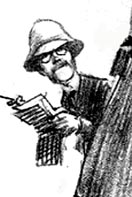Introduction

Leonard Raven-Hill (1867-1942) was born in Bath and studied at the Lambeth School of Art, and later in Paris. He exhibited at the Royal Academy and other prestigious galleries, but was increasingly drawn to pen-and-ink work. In 1893 he became founder joint-editor of the humorous art periodical Butterfly, and in 1895 he started contributing to Punch, joining its staff in 1901. He went out to India in the winter of 1902, capturing the historic moment when Lord Kitchener's luggage was brought on board ship at the Suez Canal (Kitchener was appointed Commander-in-Chief of the Indian Army in November 1902).
In some of his Indian sketches, such as the one showing him with the "Cashmere giant," Raven-Hill calls himself a war correspondent. He certainly travelled widely there and spent time with the British troops stationed in various places. In "Mail Day," even the memsahib and a pet dog are shown in an encampment. This particular picture could have been sentimental, but the poignant raptness with which the young couple are reading their letters from home is undercut by the insouciance of the figure in the middle, reading his newspaper with equal relish (this is surely their visitor, the short-sighted and cigar-puffing Raven-Hill himself). From later sketches it is clear that another purpose of the cartoonist's visit was to cover the Delhi Durbar which took place on New Year's Day 1903, marking Edward VII's accession as Emperor of India.
Raven-Hill was an Imperialist, as his sketches of the ruined Residency in Lucknow suggest, and he gives vivid snapshots of the Raj in sketches like "Ayah and Chaprassi." He seems to have found many aspects of Indian life (like the Indian mail system!) amusing. But, to his credit, he also invests the "natives" with a certain dignity (as in the case of Muhammad Khan Killadar), or at least depicts them with affectionate humor. A delightful example here is of the "mild Hindoo sightseeing." While the more curious aspects of Indian life caught his cartoonist's eye, he also responded to our common humanity. For example, he evokes the bond between father and child in "Going to the Festival, Jaipur." Here, the father steps out proudly while his little daughter holds his hand, looking solemn and a little uneasy in her formal attire. Even when Raven-Hill's subjects are sitting or standing still, he is able to capture the tension of the living moment: witness the grim, focused intensity of "The Official Photographer of the Durbar."
Amongst Raven-Hill's other works as a cartoonist, caricaturist and illustrator, he provided the illustrations for Kipling's Stalky & Co (1899). Hence no doubt his interest in the small place called "Kim" on his train route from Bombay to Delhi. — Jacqueline Banerjee
Discussion
London Life
- The Hooligans
- A Corner in Petticoat Lanes
- A 'Schnorrer' (Beggar) of the Ghetto
- Sandwich-Men
- Precaution: “Penny Cigar, an’ a Penny ’Eadache Powder!”
- “Do you stop at the Cecil?”
- Fish!
- Its Latest Application
- “Wot’s it say, Bill?”
- Quite Another Story
- Our Theatricals
- An Imaginary Line
Country Life
- A Blank Day
- Logical
- Useful Information
- I’m sorry to hear you’ve been ailing, John
- Thames Tragedies
- “Now why doan't 'ee 'ave two, pair”
- The Green-Eyed Monster
- "So you ain't had no luck this morning?
Men, Women and children
- No sentiment
- “Shall I smile?”
- A Little Knowledge, &c,”
- A Crisis
- Leopards and Spots
- L. Raven Hill (self-portrait)
- Miss Raven Hill
Travel
Drawings and cartoons about India
- Goodbye to England (setting sail for India)
- Travel to the Durbar, and in Delhi
- Muhammad Kahn Killadan (Holder of the Fort), Delhi
- The Cashmere Giant 7 ft 9 in, Delhi
- Kim
- Going to the Festival, Jaipur
- The mild Hindoo sighteeing
- Ayah and Chaprassi
- The Offical Photographer of the Durbar
- Lord Kitchener's baggage comes aboard
- Mail Day is the great day
- The Indian Mail
- Memories of the Mutiny
- Memories of the Mutiny
- Punch on travelling to the Durbar and in Delhi (4 cartoons by Raven-Hill)
Punch title-pages and frontispieces
Sources
Knox, E. V. (rev. Simon Turner). "Leonard Raven-Hill, 1867-1942." The Oxford Dictionary of National Biography. Online ed. Viewed 29 September 2007.
"Leonard Raven-Hill." However, note that, to Lord Curzon's disappointment, the Durbar was attended not by the new Emperor himself, but by the Duke of Connaught. See also "The Delhi Durbar."
Last modified 17 August 2017